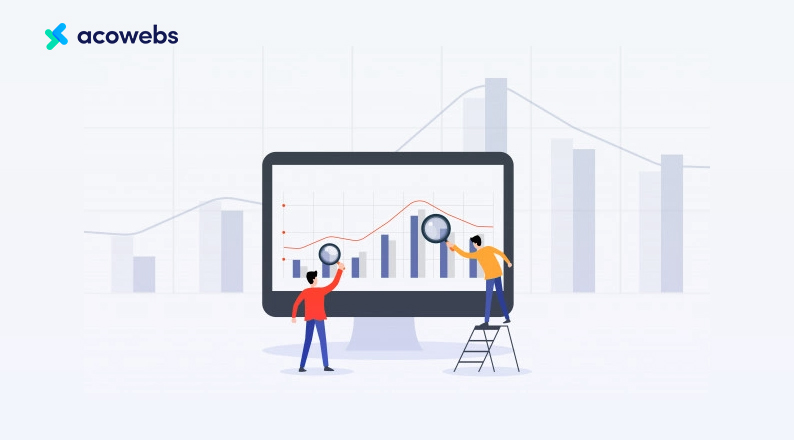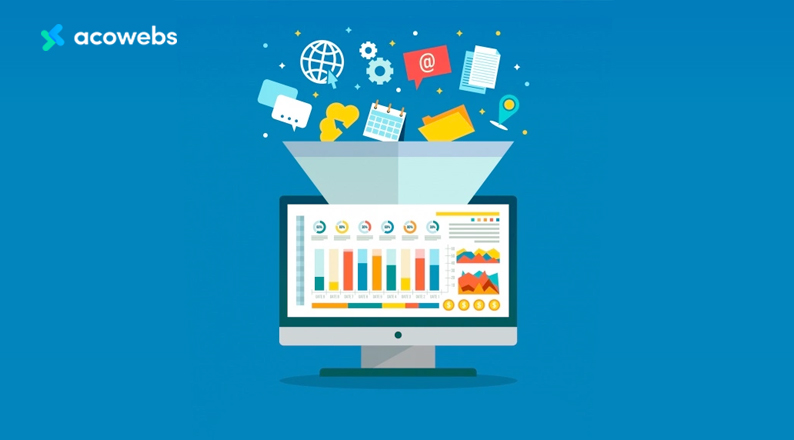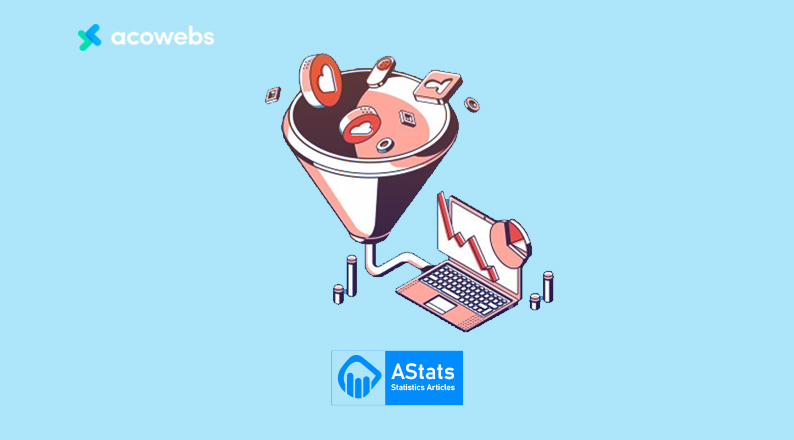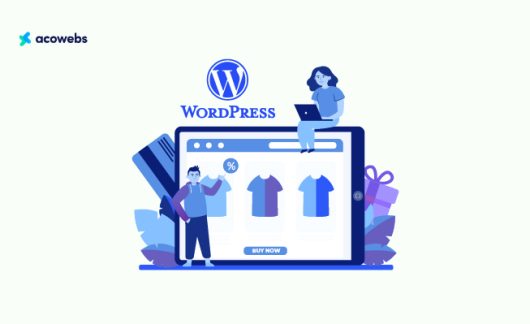Table of Contents
Businesses have seen a change that shook the way they worked and sold, with the arrival of electronic retail services to the world.
eCommerce involves transacting for goods and services online, which has become a common practice post-digital transformation that built convenience and comfort of shopping.
Most of the buyers prefer online shopping from eCommerce websites, due to two major reasons:
- The convenience of purchase and availability at the fingertips
- Budget-friendly or affordable than the physical purchases
Competitive prices are the most stunning part of the online eCommerce retail segment.
The number of digital buyers also increased tremendously, contributing to amazing statistical evidence that portrays the success of the eCommerce sector.
eCommerce Conversion Rate can be described as the ratio between transactions to sessions, which is expressed in terms of a percentage value.
Calculation of eCommerce Website Conversion Rate
You can measure the conversion rate for the eCommerce operations with the following method.
The transaction involves sessions/ total number of sessions = Conversion Rate
We consider sessions instead of the unique visitors to the site. The session can be described as the individual visits made in a certain time period. This is mostly measured in 30 minutes.
For instance, when a particular visitor makes two visits within the same period one session is recorded.
If the customer makes a visit again once the 30 minutes have elapsed, then the second visit would be considered as the next separate session.
With the session, you can understand the purchase behavior and user intent, which is not counted for unique visitors, as the shopping event is different from it.
Customers might make visits for multiple time periods, and every visit can be an opportunity for the business to Mark sales, so sessions are more effective.
This blog is meant to draw inferences regarding the growth, journey, and various factors creating an impact in the eCommerce sector. Let us have a look in detail at the various eCommerce statistics and trends.
The following statistics can also be beneficial for businesses to understand and implement the statistical trends into their operations so that they can improve the online conversion rates.
ALSO READ: How eCommerce businesses can turn organic traffic into valuable leads
General eCommerce Statistics

Credit cards are the topmost preferred method of payment by shoppers globally. (Source)
About 42% of the online shoppers preferred shopping online using their credit cards.
While the next 39% of the buyers preferred electronic payment methods, preferably the PayPal method, the debit card transaction was counted to only 28%.
The users who opted for the payment through Cash On Delivery methods grew to reach 33%.
Average Online orders made from PC devices overpower those made from Tablets as of 2020. (Source)
Though the number of mobile users has improved, it is surprising to note that despite this, desktop users rank on the top for making most eCommerce orders online.
The average order value through eCommerce platforms among desktop users is about 120.51 USD, the tablet users are 87.18 USD, and the mobile phone users are 84.69 USD respectively.
The UK remains to be the most leading market for online shopping (Source)
Online shopping has triggered in the markets across the globe. The top-ranking country for online shopping reach is the UK with 78.5% growth, followed by Japan with 73% and the US with 71.1% penetration into the global market growth rates.
Food & Drink eCommerce business triggered conversion rates of about 7.24%. (Source)
The most triggered product type in the eCommerce business is food and drink with more than 7.24% of the conversion rates invoked. People go for quick delivery and quality packaging while these are considered for purchase.
Fitness industry is the best converting on Facebook with 14% conversion rate. (Source)
The fitness industry has made a huge conversion rate with Facebook campaigns. The technology industry has a weaker side, when Facebook conversions are considered, they count to only 2.31% conversion rate.
Though we won’t have to consider a pleasing social media conversion rate, ROI always can keep your business satisfied.
eCommerce Conversion Rates Statistics
The retail eCommerce sales revenue is expected to reach 5.4 trillion USD by 2022. (Source)
There was a huge shift in eCommerce revenue from 2014 to 2024. From the revenue of 1.3 trillion USD in 2014, it took a huge leap to 4.28 trillion USD in 2020.
It is expected to hit a huge growth of 5.4 trillion USD by the end of 2022 and 6.3 trillion by the end of 2024. Also, the most popular eCommerce activity globally is Online shopping.
The global digital buyers saw an increase from 1.32 billion in 2014 to 2.14 billion in 2021. (Source)
The above statistics show that the number of digital buyers across the world has increased appreciably from the year 2014 to 2021.
About 2.14 billion buyers are expected to purchase products and services digitally by the end of 2021.
Online Shoppers conversion rate was 2.06 % in the US as of 2020. (Source)
During the first quarter of 2020, the conversion rate of online shoppers worldwide was 2.01%, followed by 2.08% in the second quarter of the same year.
However, the third quarter proved that the website visits converted into purchases came down to 2.06% in the US.
The global conversion rate of online shoppers is 2.17% as of Q3 2020. (Source)
The major challenge faced by eCommerce websites is retaining and maintaining the interests of online customers.
As of the first quarter of 2020, the global conversion rate of shoppers who purchased digitally was 2.14% and it changed to 2.25% in the next quarter.
The conversion rate again saw a slight change to 2.17% in the third quarter of 2020.
Global online shopping cart abandonment has been at a rate of 69.57%. (Source)
The shopping abandonment rate worldwide has seen an unsatisfactory increase from 59.8% in 2006 to 69.57%.
The fact is that many online shoppers have initiated an abandonment of the online shopping cart just moments before the purchase is about to be complete.
eCommerce online activity for the cosmetic segment in France saw a decline of 40% as of March 2020. (Source)
Post the outbreak of the COVID-19 Pandemic, the eCommerce online activity was fluctuating, especially among the cosmetic industry in France.
It is found that the conversion has slowly seen a decline at the end of March compared to the previous months.
As of the data of March 2020, the cosmetic segment saw a downfall of 40% compared to 72% in the previous months.
The average eCommerce website conversion rate in the US stands at 2.63%. (Source)
When compared to the global website conversion rate of 4.31% in 2020, the average eCommerce website conversion rate is 2.63% in the US.
The eCommerce website conversions have shown improvement when the data of 2019 is concerned, with 2.58% for global and 2.57% for the US market conversion rates.
Shopping cart abandonment emails have made appreciable conversion rates in retail and luxury brands. (Source)
The shopping cart abandonment reminder emails sent by eCommerce businesses to customers have been successful in transforming prospects into buyers.
The overall conversion rates in the retail segment have been 20% and for luxury brands, it is 19.4%.
Online Buyer Behavior Statistics
The number of smartphone website visits as per the first quarter of 2021 was 69%. (Source)
The retail website traffic through smartphones as per the first quarter of the year 2021, was about 69%.
This has made an increase compared to 2020, and the same first quarter of the year saw 27% of the website visits through desktop devices and only 3% visits through tablets.
Mobile phones and desktop devices remain to be the top choices for online buyers to make orders and visit websites. The mobile market is evolving and it took only less time to overpower the desktops in revenue generation.
The order volume through smartphones after website visits was 57% in 2021. (Source)
The order volume or the average conversion value has seen an improvement among the smartphone users themselves.
About 57% of the total order volume across the world was made through smartphones, followed by 40% through desktop devices, and the least share of 3% through tablets.
The reason behind the lack of website visitor engagement in the first quarter of 2019, was the small screen size. (Source)
Mobile phones had some shortcomings in the previous years; the major fact was that mobile optimization was not into prominence and a streamlined experience with mobile applications were just sprouting up.
However, 2021 has made enormous changes, and the mobile shopping experience has been trending to be the most user-friendly and convenient for online shoppers.
66% of the online buyers checked the retailer’s app for exclusive promotional offers and discounts. (Source)
In the US, about 66% of people wanted to check and confirm if there were exclusive and personalized offers on the items they wished to purchase.
61% of them wanted to know if the offers and discounts were applicable to everyone.
For 57% of the buyers, they wanted to go through the prices offered, and 36% wanted to just navigate along with the store.
Only 14% of them actually had the intention of placing an order and making payment for the product.
Mobile devices are generally used for making pricing comparisons with in-store prices and product information. (Source)
As per the survey conducted for the eCommerce site shoppers in the US, they usually browse through mobile devices and switch between the apps to get detailed price comparison data and product/service details.
ALSO READ: eCommerce Customer Surveys
Online Check-Out Behaviour Statistics

Global E-retail sales for the year 2024 are expected to reach approximately 22%. (Source)
The E-retail business has been attracting customers due to its accessibility, and wide range of discounts, offers, and additional services they offer.
Many consumers keep purchasing their products and services online. The total retail sales made in 2020 was 18%, while this has grown tremendously and is expected to reach at least 21.8% by the end of the year 2024.
Digital wallets and mobile wallets were used for 45% of the global e-retail transactions in 2020. (Source)
Mobile wallets and digital payments stood up in the year over other payment methods and this is expected to see a rise and hit over 50% in 2024.
Digital and mobile payment wallets are prominent in the Asia-Pacific region, with eCommerce transactions made in the year 2020.
eCommerce conversion rates are affected mostly due to a lack of preferred payment options. (Source)
While making a purchase or completing the transaction, certain errors are likely to occur.
These can be website layout problems, delivery delays, and most generally the lack of payment option you prefer, and these issues collectively influence the eCommerce conversion processes and the number of conversions made.
The leading reason why people buy online is the free delivery option. (Source)
As of the survey 2020, 53% of people said that they buy their products and services online due to the free delivery facilities available to them.
To 41% of them, the reason was the availability of free coupons and discounts. Apart from them, the next 35% of people bought online due to the reviews and 33% of them kept the return policies in their minds.
About 41% of the online shoppers abandoned their shopping cart due to the high cost of delivery. (Source)
There are certain drawbacks due to which individuals abandon the shopping cart in spite of visiting online stores.
About 41% of the online buyers decide to leave the cart because the final check-out cost appears more than what was estimated in the initial stage.
29% of the buyers compared the prices and found another site to be more profitable. Whereas 29% didn’t want the product and hence left the cart.
28% found that the product was out of stock and to 26%, the estimated delivery time was longer than they had expected.
Automated eCommerce Email Marketing Conversion Rate Statistics
The automated welcome emails sent by eCommerce businesses invoked a conversion rate of about 51.94%. (Source)
Email marketing has been widely adopted by eCommerce websites which have shown great improvement in conversions.
The automated emails especially welcome emails have created a positive feeling among the customers which made them initiate a purchase. About 51.94% of the customers have got converted due to the personalized welcome emails.
Automated cart abandonment emails sent by eCommerce websites made a conversion rate of 33.89%. (Source)
It’s natural for the prospects to forget about the things they have added to the cart. Cart abandonment needs to be reminded at certain intervals so that customers return to make a purchase.
The automated cart abandonment emails have created about 33.89% conversions and the product abandonment emails have urged about 17.35% conversion rate.
The birthday emails by eCommerce businesses have been making conversion rates of about 10.57%. (Source)
Birthday emails have also been favorable to the prospects since they felt they are considered and pampered by the retail businesses.
The birthday emails sent by eCommerce sites have created conversion rates of 10.57%.
ALSO READ: 10 Foolproof Ways to Improve eCommerce Email Engagement
Industry-wise eCommerce conversion rate Statistics

Average conversion for the Fashion and clothing accessories industry leads with a 21.70% growth rate. (Source)
With a conversion rate percentage of 1.32% in 2020 to 1.60% in 2021, the average conversion rate for Fashion and Clothing accessories segment saw a 21.7% overall growth rate.
This is then followed by the Health and well-being segment with about 18.57% growth rate, and the Sports & Recreation segment with about 6.24% growth rate.
Home accessories, giftware, baby&child industry lags in terms of eCommerce conversions with a decline in growth rate. (Source)
The online business for Home accessories and giftware had witnessed a drop in their conversion rates from 1.31% in 2020 to 0.95% in 2021.
Additionally, the baby or child segment has also experienced a decline in terms of conversion rates from 1.14% in 2020 to 0.75% in 2021. The decline in growth rate for both the sectors is -27.34% and -33.98% respectively.
The sales growth rate of the eCommerce segment is dominated by Home Accessories and Giftware with about 115.24% growth rate. (Source)
As per the eCommerce sales data, the overall sales growth rate is dominated by the Home accessories and Giftware with a growth rate of about 115.24%, which is followed by Fashion Clothing & Accessories with a 12.49% growth rate, then Kitchen & home appliances with about 9.77% growth rate.
The overall online conversion rate has reached 2.3 % and the conversion rate per user is 4.6%. (Source)
Selling Online products and services, has seen an upsurge in the buyers and their interests. The conversion rate has also been triggered due to the high competition among various businesses.
As per the KPI report of Wolfgang Digital, it has been found that the overall conversion rate has grown to 2.3% and the conversion rate recorded per user is 4.6%.
Country-based eCommerce Conversion Rate Statistics
Germany ranks first with a 2.22% Conversion rate. (Source)
Germany leads with an average conversion rate of 2.22%, while Italy lags with a conversion rate of only 0.99%.
The United States grabbed the second position with a conversion rate of 1.96% and the United Kingdom with 1.88%.
The overall B2C turnover growth rate for Western Europe is the topmost with 4%. (Source)
According to the E-GDP 2020, B2C eCommerce turnover growth rate for various countries was considered.
Among them, Western Europe stands first with a 5.19% conversion rate and growth rate of 4%. Northern Europe stands next with a 3.48% conversion rate with a growth rate of 3%.
47% of online consumers from the UK make their purchase 6 times or more. (Source)
The frequency of purchases can decide the success of an online eCommerce store. eCommerce is trending worldwide and more people are pushed towards buying online.
47% of the UK customers make their purchase 6 times or more, this is followed by Germany with 32%.
ALSO READ: 10 Ways to Create Product Videos for eCommerce
Traffic-Based eCommerce Conversion Rate Statistics

Social media visitors are targeted more by the Business pages to convert. (Source)
Social media visitors are considered to be more convertible, hence the business pages target more of these visitors with a 6% conversion rate and the paid traffic is only contributing to the next 3% of the conversion rate.
While the organic traffic accounts for a rate of 3.8%.
Before confirming a purchase, the apparel and grocery shoppers view at least 32 pages. (Source)
A purchase is not that easy, it involves the transformation of decisions and multiple comparisons before leading to it.
The grocery and apparel consumers view at least 32 pages before they confirm a purchase. Energy segment consumers visit a minimum of 26 pages before they make a purchase.
Reading Ease Based eCommerce Conversion Rate Statistics
It is found that the Apps and devices pages are more convertible. (Source)
The apps and devices pages have easy-to-understand content, hence customers find it user-friendly and easy to digest.
Hence the conversion rates are skyrocketing in this segment with the right SaaS business metrics. This is followed by SaaS baseline and cybersecurity pages.
Data and Information related pages are quite difficult to understand. (Source)
Technical information and language make things complicated, more people are likely to increase bounce rate rather than getting converted. Hence, data and information-related pages are more difficult to understand.
Payment-Based eCommerce Conversion Rate Statistics

PayPal transactions constitute more than 70% of more checkout rates when compared to other transactions. (Source)
PayPal is trending among customers. Online consumers believe they are more comfortable and secure with the PayPal transactions when other modes of transaction are considered.
Customers using Paypal are more converting compared to the others.
Non-PayPal transactions have only about 46.4% check-out conversion rate, whereas Paypal transactions have 79.1%. (Source)
When compared to the Paypal transaction rate of 79.1%, the non-Paypal transactions count to about only 46.4% transactions.
This clearly proves the demand for Paypal transactions. Hence retailers with Paypal as a transaction method can have more chances of customers to convert.
Platform-Based eCommerce Conversion Rate Statistics
Windows has grabbed the maximum conversion rate with a 4.94% value. (Source)
The operating system Windows has made a conversion rate of 4.94%, while the next position is grabbed by Macintosh with a 3.78% conversion rate.
Chrome OS also comes in the next position with about 2.89% conversions made.
Linux OS makes fewer conversions but larger website visits. (Source)
It is surprising to know that though Linux makes a huge number of website visits and drives traffic, the customer conversions are very low with Linux OS.
About 0.02% is the conversion rate with Linux users and the website visits were 68.75% for engagement and followed by iOS at 22.41% traffic engagement rate.
ALSO READ: How to effectively use Heatmaps for your eCommerce store
Wrap-Up
There is a long list of processes running through the mind before a shopper adds a product or service to the cart, or before proceeding to checkout.
And triggering these psychological concerns of users is really important.
And if you wonder how to do this, then here is all about it!
Apply a Conversion Intelligence Strategy to your business with these reports.
Boost your next campaign or event with the conversion intelligence approach.
Benchmarking involves a series of steps, you can first have a glance through the all above-mentioned reports with values that give you more inferences on how to move tactically.
You can start with the statistics relevant to your niche and segment, but there are still plenty of trends and patterns even outside your niche that can correlate with that of yours.
The next step is to apply what you have learned to the campaigns you have planned for the future. Make variants of your pages and apply our insights to the pages made.
You can, for instance, work on the readability score, and make it easy to understand and confirm that they help you in improving the conversion rates.
A/B testing is necessary, you can test the results in various ways and catch what attracts your consumers more. Now the rest of the things are ready to build and easier. Learning is another integral part of your understanding.
The above report is based on recent data trends and surveys collected from various sources, however, you can still learn much more with these contexts linked to our niche.
Try making new approaches like for example, the offers, discounts, free delivery, etc., and enhance the conversion rates of your business.
Acowebs are developers of Woocommerce bulk discounts that will help you add bulk discounts to products on your stores. It also has developed various other plugins like the popular plugin for managing the checkout form fields in WooCommerce, called Woocommerce Checkout Manager, which is highly feature-oriented yet lightweight and fast. There is also a free version of this plugin available in the WordPress directory named WooCommerce Checkout Field Editor.











 Login
Login
 Cart
Cart








